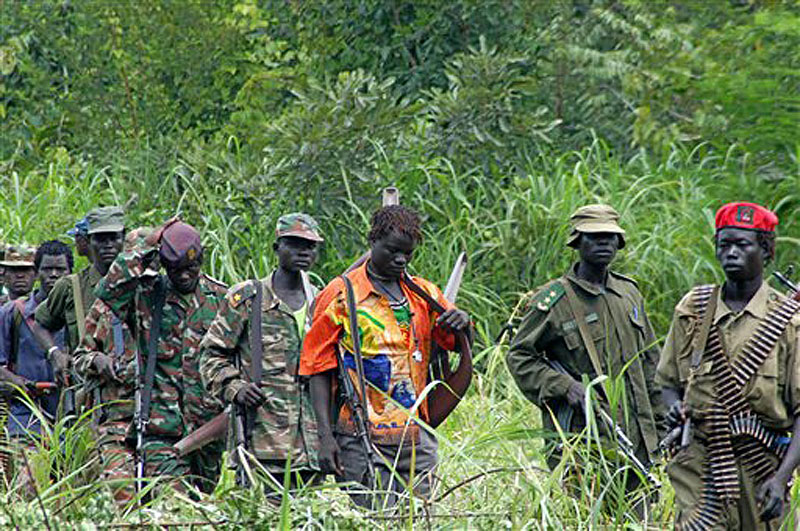KAMPALA, Uganda — If Joseph Kony lived in relative anonymity before this week, he’s an Internet star now.
A video about the atrocities carried out by Kony’s Lord’s Resistance Army has gone viral, racking up millions more views seemingly by the hour.
The marketing campaign is an effort by the advocacy group Invisible Children to vastly increase awareness about a jungle militia leader who is wanted for atrocities by the International Criminal Court and is being hunted by 100 U.S. Special Forces advisers and local troops in four Central African countries.
The group’s 30-minute video, which was released Monday, had more than 32 million views on YouTube by Thursday. The movie is part of an effort called KONY 2012 that targets Kony and the LRA.
“Kony is a monster. He deserves to be prosecuted and hanged,” said Col. Felix Kulayigye, the spokesman for Uganda’s military.
But Kulayigye said that Kony’s forces — once thousands strong — have been so degraded that he no longer considers Kony a threat to the region. Because of the intensified hunt for Kony, his forces split into smaller groups that can travel the jungle more easily.
Experts estimate that the LRA now has only about 250 fighters. Still, the militia abducts children, forcing them to serve as soldiers or sex slaves, and even to kill their parents or each other to survive. The LRA now operates in Congo, the Central African Republic and South Sudan.
Uganda, Invisible Children and (hash)stopkony were among the top 10 trending terms on Twitter among both the worldwide and U.S. audience on Wednesday night, ranking higher than New iPad or Peyton Manning. Twitter’s top trends more commonly include celebrities than fugitive militants.
Jolly Okot was abducted in 1986 by the militia group that later became the LRA. The then-18-year-old could speak English so was valuable to the militants. She was also forced to have sex.
Today, Okot is the Uganda country director for Invisible Children, in charge of 105 employees. She said the group is helping 800 people affected by LRA violence to attend high school and university. She said the program has given hope to kids who previously dropped out of the education system.
“The most exciting thing about this film is that I’m so grateful that the world has been able to pay attention to an issue that has long been neglected,” Okot said. “I think it is an eye-opener and I think this will push for Joseph Kony to be apprehended, and I think justice will get to him.”
International Criminal Court Prosecutor Luis Moreno-Ocampo said it has been hard to raise public awareness about Kony since issuing his warrant in 2005.
“Kony is difficult, he is not killing people in Paris or in New York. Kony is killing people in Central African Republic, no one cares about him,” he said. “These young people from California mobilizing this effort is incredible, exactly what we need.”
He praised the group that made the film.
“They are not fighting, they are just putting the right focus: stopping the crimes, arresting Kony, helping people,” he said. “Perfect.”
Ben Keesey, Invisible Children’s 28-year-old chief executive officer, said the viral success shows their message resonates and that viewers feel empowered to force change. It was released on the website www.kony2012.com.
The burst of attention has also brought with it some criticism on Internet sites of Invisible Children’s work, including the ratio of the group’s spending on direct aid, its rating by the site Charity Navigator, and a 2008 photo of three Invisible Children members holding guns alongside troops from the country now known as South Sudan.
Invisible Children posted rebuttals to the criticism on its website, saying that it has spent about 80 percent of its funds on programs that further its mission, about 16 percent on administration and management, and about 3 percent on fundraising. The group said its accountability and transparency score is currently low because it has four independent voting members on its board of directors and not five, but that it is seeking to add a fifth. The group said the three workers in the photo thought it would be a good “joke” photo for family and friends.
Kony’s Ugandan rebel group is blamed for tens of thousands of mutilations and killings over the last 26 years.
Rear Adm. Brian L. Losey, the top U.S. special operations commander for Africa, told reporters last month that U.S. troops are now stationed in bases in Uganda, Congo, South Sudan and Central African Republic as part of the anti-LRA fight. Losey said there’s been a decrease in the lethality of LRA activities attributable to U.S. and partner nation efforts.
Ruhakana Rugunda, the Ugandan diplomat who led the country’s failed peace negotiations with Kony in 2006, said the work of organizations such as Invisible Children preserves the memory of an insurgency whose brutal legacy should never be forgotten. The talks with Kony, mediated by South Sudan, ended in 2008 after the rebel leader refused to sign the final peace agreement, saying he could not guarantee his security once he left the bush.
The last known images of Kony show him shaking hands, and sometimes smiling, with dignitaries visiting his camp. Some images showed him wearing a suit and shiny black shoes.
“Kony gives you the impression that he is harmless, that he cannot catch a fly,” Rugunda said, recalling his conversations with Kony, who was an altar boy before he became an elusive rebel leader.
Rugunda last saw Kony in a forested camp in eastern Congo before the rebel leader and his men fled to the Central African Republic, where they have retained the capacity to harass villagers for food.
Rugunda said that capturing Kony alive would set in motion a “full accountability mechanism” in which the world would get to know how it came to be that Kony committed the many crimes he is accused of.
Send questions/comments to the editors.


